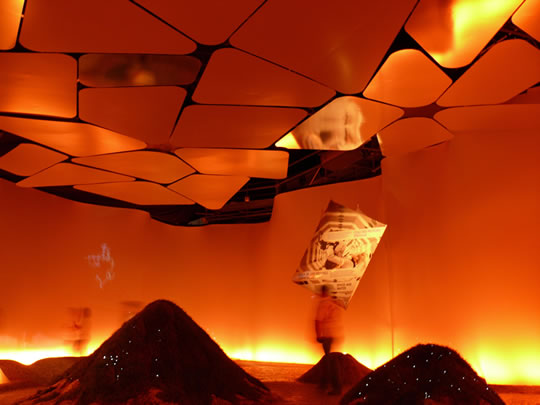 The Sete Pavilion headed by Pietro Laureano for the Saragossa Universal Show on Water is the most visited in its category.Great public success of the Zaragoza Universal Exhibition, which is the theme of water running from June to September 2008. The exhibition is made up of spectacular architectures including the Kalavatra Water Museum Bridge and the Water Tower and Ten thematic pavilions. The thematic hall of the Sete, whose scientific direction was entrusted to the architect Pietro Laureano with 140,000 appearances in the first week of opening, is the only thematic pavilion to be among the top ten most visited installations.
The Sete Pavilion headed by Pietro Laureano for the Saragossa Universal Show on Water is the most visited in its category.Great public success of the Zaragoza Universal Exhibition, which is the theme of water running from June to September 2008. The exhibition is made up of spectacular architectures including the Kalavatra Water Museum Bridge and the Water Tower and Ten thematic pavilions. The thematic hall of the Sete, whose scientific direction was entrusted to the architect Pietro Laureano with 140,000 appearances in the first week of opening, is the only thematic pavilion to be among the top ten most visited installations.
We include excerpts from his presentation of the pavilion made by Pietro Laureano:
The pavilion of thirst is shaped like a salt mountain reflecting the rays of the sun, making it look like a mirage in the desert. Inside it is a machine made with a very advanced technology. Recovered water catchment systems of caves, water production techniques for underground tunnels called drainage tunnels and air shafts. The visitor understands that it is possible to obtain water that can be brought from the sky and the subsoil. That the need for drinking water has allowed to develop extraordinary techniques, culture and knowledge. But all this is the past? Are we visiting an archaeological museum of obsolete techniques? No. Continuing on the path, the visitor finds himself traveling on an elaborate technological-environmental device that, in flight in the cosmos, uses palletics for recycling, water production and sustainability. It’s a spaceship-greenhouse; A space-ecosystem station; A guardian of water wisdom; A drop of water traveling to the universe; A planet – garden. Even our planet Earth is a spaceship traveling to the cosmos. Visitors to the exit can be informed of the kilometers traveled during his presence in the pavilion and the amount of water moved in his own body. The metaphor pavilion of thirst hides within it a mystery. A journey through water, culture and knowledge techniques will overcome the current ideas on thirst.
Exposure allows the visitor to understand what is thirst for answering questions: Who is thirsty? What happens because of thirst? How do we treat thirst? What is thirst? It answers this latter question by providing a new vision of thirst. Thirst is needed: by problem is a resource: a drive to travel and knowledge.

Thirst is an irrepressible need, a sense of extreme dissatisfaction, a desire to act and to know: it is the engine of cultural and environmental transformations. Living organisms and the environment manifest their thirst as an urgent need and with signs of dissatisfaction and degradation. Skin is for man what the landscape is for the ecosystem. If the body is thirsty the skin is dried, it is dehydrated. So the waterless soil breaks down and degrades. But the landscape of thirst is not that of the desert is that of desertification. Desert and desertification are two different things. The desert has a precise ecological equilibrium affirmed over time in specific climatic situations. Its landscape is healthy with an aesthetic value, with laws, components, biological and cultural activities adapted to respond appropriately to thirst for plants, animals and men. Desertification is caused by the pressure and malicious intervention of humans and can occur in any climate and situation, resulting in conditions of disequilibrium with degraded soils and places that are totally harmless.

Desertification is the lack of satisfaction of the thirst for the ecosystem. So organisms disappear, humans and even plants migrate. Without water you have to go to another place or find ways to get it. Thirst is an impulse, a recall that must be answered. Thirst is at the origin of two fundamentally related phenomena: movement and civilization. Thirst has pushed humanity into discovery, knowledge and innovation. The water need of our organism and ecosystems is a resource because it is a stimulus to further progress.
The water crisis caused by global warming and climatic extremism will be a stimulus to change the economic model, the birth of a new paradigm based on a pact between humanity and the environment, and the development of sustainable technology. Thirst is the manifestation of the still unknown principles of the Universe. The inextinguishable need for continuous fusion with the water cycle, the planetary and the cosmic cycle. Thirst is the need and the desire, it is part of our nature, from distant origins to future destiny. The thirst accompanies the perennial journey of discovering humanity: from the cave to the space station and beyond to the infinite.









